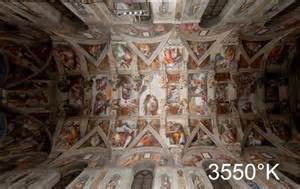Osram and LED lighting have solved a decades-long problem for visitors to the Sistine Chapel in Vatican City.
Next month, 7,000 LED lights will be turned on so the chapel ceiling will be fully lit, allowing art lovers to see the works of Michelangelo better than ever before.
People who wanted to see the 450 year old paintings were forced to strain their eyes since the 1980’s, because natural light was damaging the artwork. Vatican officials and art experts decided to block the windows and use Halogen lamps to light the artwork. But the bulbs did not provide the desired effect on Michelangelo’s colors.
So, the Vatican started to work with Osram to design a system that combines colors from LED lights to bring out the true tones of the artwork. The LED will not fade the colors, and also have a long life of their own.
On it’s webpage, Osram describes the project:
Five and a half million visitors crowd into the chapel each year to see Michelangelo’s works, but they witness only a few in full glory because a lighting level approximating twilight is usually experienced. A new type of lighting from OSRAM will change this from next year: illuminance levels will increase, energy consumption will be cut and the art will be carefully conserved.
Experts use the term ‘mesopic’ for the low-contrast twilight usually found in the chapel that impairs color perception and contrast. This quality of light is due to former technical limitations, the currently installed lighting technology originating from the 1980’s. Eight 150 watt HQI spotlights and two 1,000 watt halogen projectors are currently installed on the outside of each of the 12 chapel windows. Their high connected load though is only sufficient for illuminance values of a few lux on the artworks, because semi-transparent plastic covers have been installed in front of the windows to protect the art from ultraviolet radiation. These are intended to block damaging radiation but also absorb plenty of light.
Lighting experts from the company of OSRAM developed a sophisticated LED lighting concept that increases illuminance by five to ten times, elevating the colors from the semi-darkness of twilight and illuminating the complete color spectrum of the frescoes in highly homogeneous and optimally controlled light. The development was implemented within the framework of a project subsidized by the European Union with a consortium of various development partners including lighting planners, conservationists and energy and light measurement technicians.
The technical basis of the project is an LED luminaire similar to ones recently used in the reopened Lenbachhaus art museum in Munich, Germany. For that project OSRAM engineers developed a luminaire from scratch featuring red, green, blue as well as warm white and cool white LED light. The five color channels of the luminaire can be independently controlled to allow fine adjustment of the color temperature between 3,000 and 6,000 Kelvin in accordance with changing works of art in the exhibition spaces. In the Sistine Chapel on the other hand, the frescoes will be embellishing the walls and ceilings for a long time to come; a range between 3,000 and 4,000 Kelvin was thus sufficient.
Simultaneously, control options inherent with LED technology are exploited to the full, and the aim was to achieve an impression of color that more closely justifies the high component of saturated colors in the frescoes. The first stage in the project was the non-contact analysis of fresco pigmentation at 280 points on the Renaissance paintings by colorimetry experts from the Pannonian University in Hungary, the analysis points being illuminated with a calibrated light source and the reflected spectrum measured. This actual color response (and not the classic color rendering index) then serves as a benchmark for the fine spectral adjustment of the LED luminaires. Today, experts assume that Michelangelo did not mix his colors under candlelight or the light of torches but with daylight and thus with a cooler color temperature. The chapel though is illuminated with LED light at 3,000 Kelvin, and so a sophisticated correction algorithm was developed that integrates the differing color perception of the human eye with various color temperatures into the spectral distribution of the LED light. It is highly probable that visitors in the future will be able to experience the interplay of fresco colors just as Michelangelo once intended, and such ambitious fine-tuning is currently only possible with light emitting diodes.

Each luminaire is also mounted at three points due to the unevenness of the cornice and is positioned with high precision. LED spots will also be installed and are intended to replace the obsolete gala lighting used with fairs, concerts and of course the conclave. 30 LED spots each with 50 watts are mounted in groups of three between the windows, and when needed these can be manoeuvred from their hideout on the ledge with power-assisted motion. If not needed, they remain concealed. Despite significantly higher illuminance values and maximum light quality, the LED installation achieves top values in terms of electricity overheads, electrical power consumption of the chapel including gala and visitor lighting being reduced from over 66 kilowatts down to 7.5 kilowatts.
Photos courtesy of www.osram.com.
Tagged with lighting, tED